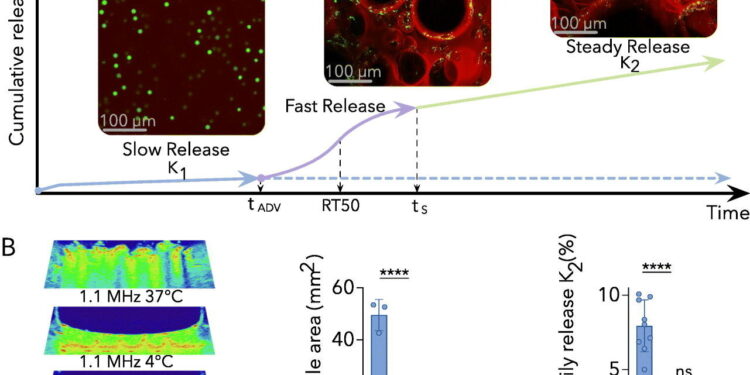Credit: Controlled release log (2024). DOI: 10.1016/j.jconrel.2024.08.001
Researchers at Michigan Medicine have developed a composite hydrogel capable of achieving sustained and consistent drug release using ultrasound as a trigger.
The team behind this breakthrough believes it could revolutionize drug delivery for various medical applications, in which consistent drug levels are crucial for optimal therapeutic outcomes.
The resulting article, “Acoustically responsive scaffolds: Unraveling releasing kinetics and materials for sustain, steady drug delivery” appears in the October 2024 issue of the journal Controlled release log.
The composite, called an acoustically responsive scaffold, uses a fibrin hydrogel matrix.
When exposed to ultrasound, an emulsion embedded in the hydrogel vaporizes into bubbles, releasing the encapsulated drug.
There are drug delivery devices, such as osmotic pumps, that provide zero-order release, that is, constant release over time.
However, these methods often present limitations that this fibrin hydrogel could overcome.
“A key advantage of our system is its use of fibrin, a biocompatible material that naturally degrades in the body,” said Haijun Xiao, Ph.D., a researcher at the Michigan Medicine Ultrasound Laboratory and lead author of the paper.
“This eliminates the need for surgical removal of the drug delivery device after treatment, as is sometimes necessary with other implantable systems.”
The ability to control ultrasound allows for zero-order sustained release, a process for delivering a consistent level of drug over an extended period of time.
“This version can improve treatment effectiveness and minimize side effects associated with fluctuating drug concentrations,” Xiao said.
Xiao developed stepwise equations to specifically describe the multiphasic release behavior of acoustically responsive scaffolds, which involves an initial rapid release upon ultrasonic activation followed by a sustained zero-order release phase.
These equations provide a new framework for designing and optimizing ultrasound-triggered drug delivery systems.
The Michigan Medicine Ultrasound Laboratory has already pioneered the use of these scaffolds to stimulate blood vessel growth.
Applying this technology to drug delivery offers several advantages: on-demand drug release, personalized treatment regimens, and non-invasive dose adjustments.
“Having a mathematical model that accurately describes the ARS release process is crucial to ultimately personalizing treatment,” said Mario L. Fabiilli, Ph.D., principal investigator in the Ultrasound Laboratory and main author of the article.
“In the future, these equations will allow us to precisely adjust the drug dose non-invasively to meet individual patient needs.”
The research team is currently exploring the development of acoustically responsive scaffolds capable of delivering multiple growth factors sequentially, potentially creating the possibility of more sophisticated tissue engineering and regenerative medicine applications.
More information:
Haijun Xiao et al, Acoustically Responsive Scaffolds: Unraveling Release Kinetics and Mechanisms for Sustained and Regular Drug Delivery, Controlled release log (2024). DOI: 10.1016/j.jconrel.2024.08.001
Provided by University of Michigan
Quote: Hydrogel with ultrasound activation allows sustained drug release (September 28, 2024) retrieved September 28, 2024 from
This document is subject to copyright. Except for fair use for private study or research purposes, no part may be reproduced without written permission. The content is provided for informational purposes only.



